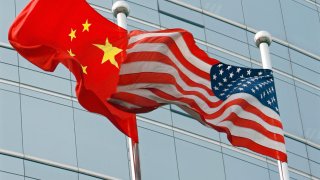
- China's purchases of U.S. goods are still falling short of trade agreement levels, according to the U.S.-based Peterson Institute for International Economics.
- Chinese Foreign Minister Wang Yi said Monday at a meeting with U.S. Deputy Secretary of State Wendy Sherman that the U.S. should remove tariffs, as part of three broader requests from China laid out in a release.
- Ministry of Commerce Spokesman Gao Feng declined at a July 15 press conference to confirm whether the phase one agreement was still being implemented.
BEIJING — China's purchases of U.S. goods are still falling short of trade agreement levels, even as overall Chinese imports from the U.S. have surged.
That's according to analysis out Monday from the U.S.-based Peterson Institute for International Economics.
In January 2020, before the coronavirus pandemic and under former U.S. President Donald Trump, China agreed to buy at least $200 billion more in U.S. goods and services over the next two years, relative to the 2017 level. Known as the phase one trade deal, the purchase agreement included specific agriculture, energy and manufactured products.
Get top local stories in Philly delivered to you every morning. Sign up for NBC Philadelphia's News Headlines newsletter.
However, as of June, both Chinese and U.S. government data indicated that China had bought less than 70% of the year-to-date target, according to estimates from Peterson Institute senior fellow Chad P. Bown.
Agriculture purchases again came the closest to meeting agreement levels, at 90% of the target, according to U.S. data that Bown cited.
Money Report
The shortfall comes as trade between the two countries has grown, according to Chinese customs data.
China's imports from the U.S. in the first half of the year rose to $87.94 billion, up 55.5% from the same period in 2020 and up nearly 49.3% from the first six months of 2019.
Meanwhile, China exported $252.86 billion worth of goods to the U.S. in the first half of 2021 — up 42.6% from the same period in 2020 and a rise of 26.8% from the first half of 2019.
As a result, the U.S. remains China's largest trading partner on a single-country basis, despite trade tensions that escalated under the Trump administration.
U.S.-China trade talks at a standstill
In the last few years, under the Trump administration, the U.S. has imposed tariffs on billions of dollars' worth of Chinese goods in an effort to address long-standing complaints about issues such as lack of market access and intellectual property protection. Beijing responded with its own duties on U.S. goods.
Since taking office in January, President Joe Biden has retained Trump-era tariffs and sanctions on major Chinese technology companies such as Huawei, while announcing additional sanctions on Chinese entities.
But Biden has "not yet articulated a trade strategy or another approach that would really be effective in countering China's economic strength," Michael Hirson, practice head for China and Northeast Asia at Eurasia Group, said Monday on CNBC's "Squawk Box Asia."
During a high-level meeting between the two countries' officials on Monday, Chinese Foreign Minister Wang Yi said the U.S. should remove tariffs, as part of three broader requests from China, the ministry said.
Senior U.S. administration officials did not mention tariffs in a call with reporters about the Chinese officials' meeting with U.S. Deputy Secretary of State Wendy Sherman. Rather, the U.S. officials said Sherman noted concerns about unfair trade and economic practices.
The phase one trade agreement called for a review of the deal, but that meeting has yet to take place in part due to the coronavirus pandemic and a change in White House leadership.
During the first year of the phase one trade agreement, in 2020, Chinese purchases were less than 60% of the target, based on both countries' data, the Peterson Institute said.
China's trade surplus with the U.S., which Trump tried to reduce, remained near historic highs at $32.58 billion in June, customs data showed.
At a press conference in mid-July, Ministry of Commerce Spokesman Gao Feng declined to confirm whether the phase one agreement was still being implemented.
Instead, he said China has always encouraged both sides to "work together to create an atmosphere and the conditions for implementing the agreement," according to a CNBC translation of his Mandarin-language remarks.
— CNBC's Yen Nee Lee contributed to this report.






